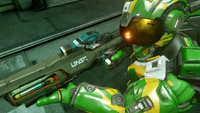MLRS-1 Hydra
From Halopedia, the Halo wiki
| Hydra MLRS-1 HGL | |
|---|---|

| |
| Production overview | |
|
Manufacturer: |
|
|
Model series: |
MLRS-1 HGL[1] |
|
Type: |
|
| Specifications | |
|
Length: |
91.44 centimeters (36.00 in)[1] |
|
Width: |
14.3 centimeters (5.6 in)[1] |
|
Height: |
15.1 centimeters (5.9 in)[1] |
|
Weight: |
11 kilograms (24 lb)[1] |
|
Ammunition type: |
|
|
Feed system: |
6-rocket revolving cylinder[1] |
|
Firing mode: |
|
|
31.86 m/s (104.5 ft/s)[2] | |
|
Effective range: |
Medium to long |
| Service history | |
|
In service: |
|
The Multiple Launch Rocket System-1 Hydra Gyroc Launcher (MLRS-1 HGL),[1] commonly known simply as the Hydra,[3][4] is a rapid-fire guided munitions launcher[4], manufactured by Chalybs Defense Solutions and used by the United Nations Space Command.[1]
It uses gyroscopically stabilized, high-explosive micro-missiles capable of locking onto enemy targets similar to the Covenant's Type-52 plasma launcher.[5] The Hydra is capable of killing a fully shielded Spartan-IV with two locked on shots in War Games.[6]
Specifications
The MLRS-1 Hydra Gyroc Launcher is a highly versatile guided missile launcher that can operate in a variety of different environments. The weapon was designed to be effective against both infantry and vehicle targets. The Hydra is designed to be as easy to operate as a conventional rifle, albeit one that fires gyroscopically stabilized High-Explosive Air Bursting (HEAB) micro-missiles from the weapon's six-chamber, revolving cylinder.[1] The Hydra's rockets are capable of homing in on targets, though they require a lock-on before doing so.[7]
Highly effective in both close-quarters combat and medium-range engagements, the Hydra can be used in a direct-fire mode though it is most deadly when using a real-time VISR connection to lock-on and guide missiles to the target. The Hydra's sophisticated semi-automatic targeting and tracking system allows the user to target not only individual infantry, but even distinct parts of enemy vehicles to effect a clean and efficient kill.[1]
Variants
- Typhon: The Typhon is an improved variant manufactured by the Office of Naval Intelligence's Watershed Division that features upgraded and improved recoil compensation, warhead damage, and reload speed.[1][8]
- Echidna: The Echidna is an advanced variant, also produced by the Watershed Division's engineers, that features experimental, non-nuclear warheads capable of generating an electromagnetic pulse. Unlike the base model or Typhon, the Echidna is capable of both a 2× and 5× zoom and can track down targets as far back as 2,040 feet (622 m).[1][8]
Operational history
The result of decades of development in refining micro-missile technology, the Hydra MLRS entered service in the United Nations Space Command in 2556, though the weapon has yet to see widespread usage beyond the Spartan branch as of October 2558. The Hydra had been utilized in a number of combat roles, including close-quarters infantry engagements, urban pacification, and ship boarding maneuvers.[1] Hydras were aboard Argent Moon during Blue Team's mission to recover the research ship in 2558.[9]
Trivia

|
Browse more images in this article's gallery page. |
- In Episode 6 of The Bulletin, fans were given the opportunity to vote for which weapon they wished to be featured in the Halo 5: Guardians Multiplayer Beta: the Hydra or the rocket launcher.[4] The Hydra won the vote.[10]
- In Greek mythology, the Hydra was a large serpent-like water monster that possessed multiple heads.
Gallery
- H5-ConceptArt-HydraMLRS.jpg
Concept art of the Hydra for Halo 5: Guardians.
A Recruit-clad Spartan-IV wielding the Hydra in a promotional image for the Halo 5: Guardians Multiplayer Beta.
A Spartan-IV using smart scope with the Hydra.
The Hydra being used on the map Regret.
A Spartan-IV using a Hydra on Escape from ARC.
First-person view of the Hydra by Fred-104 in the Halo 5: Guardians campaign.
Jameson Locke using a Hydra on Sanghelios.
First-person view of the Typhon on Raid on Apex 7.
A Helioskrill-clad Spartan-IV wielding a Hydra.
First-person view of the Echidna on Battle of Noctus.
An Indomitable-clad Spartan-IV with Echidna.
Concept art of Commander Jerome-092 with a Hydra for Halo Wars 2.
Halo 5: Guardians REQ cards
List of appearances
- Halo 5: Guardians (First appearance)
- Halo Wars 2
- Halo: Legacy of Onyx
- Halo: Official Spartan Field Manual
Sources
- ^ a b c d e f g h i j k l m n o p Halo Waypoint - Hydra Launcher
- ^ a b c d YouTube - Halo 5 | Hydra Launchers Analysis
- ^ Gamespot - How Halo: The Master Chief Collection Ties Into Halo 5: Guardians
- ^ a b c Halo Waypoint - The Bulletin: Episode 6
- ^ YouTube - Halo 5: Guardians Multiplayer Beta: Behind the Scenes
- ^ The Sprint, Shutdown
- ^ Halo Waypoint - Canon Fodder - Locke & Load
- ^ a b Halo 5: Guardians
- ^ Halo 5: Guardians, campaign level Blue Team
- ^ Halo Waypoint
| |||||||||||||||||||||||||






















